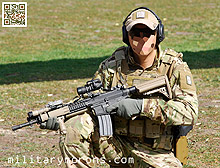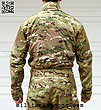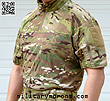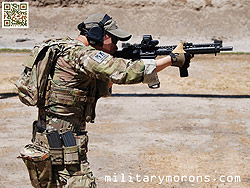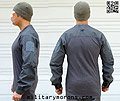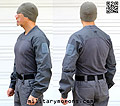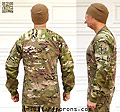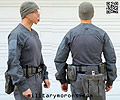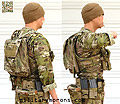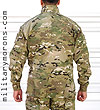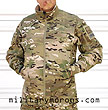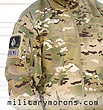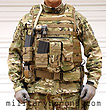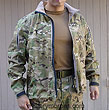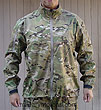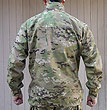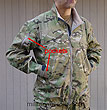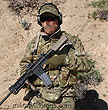Uniforms/Military Clothing page 1 page 2 page 3 page 4
TO VIEW FULL SIZE IMAGES: USERNAME and PASSWORD are both "mm"
Arc'teryx LEAF Talos Halfshell Patterned
(Note: username and password are both 'mm' to view full size images)
| 3/12/12 - The Talos Halfshell Patterned in Crye MultiCam is the matching lightweight combat shirt to the Talos Pant Patterned, from the LEAF (Law Enforcement and Armed Forces) division of Arc'teryx. It's part of LEAF's Armour Compatible Layering system. It's a no-melt, no-drip lightweight long-sleeved shirt that uses two different materials in its construction to provide hot weather comfort and durability. The Talos Halfshell also incorporates Arc'teryx's 'Roll-and-Stow' sleeve system that enables the user to convert the sleeve configuration from long to short during periods of intense physical activity. Armour Compatible Layering - Arc'teryx's armour-compatible garments are designed to work as part of a synergistic system that includes body armour and gear as part of the layering system. By including armour as part of the system, Arc'teryx created a series of products to work in conjunction with the gear, that increases comfort, performance and versatility across a wide range of activities and environments. Two of the most distinctive features is the use of hybrid construction (different weights or textile combinations), and their Roll-and-Stow sleeve system. The hybrid construction of the Talos shirt provides warm weather comfort and durability for the user, while the stowable sleeves allow a greater range of operating temperatures. The rolled up sleeve store underneath the shoulder pockets, leaving nothing exposed to snag. Material - The Talos Halfshell utilizes two different MultiCam fabrics in its construction (it's only available in Crye MultiCam): Cotton/Cordura nylon ripstop for the Shoulder yoke and sleeves - The 'top half' of the Talos Halfshell is made of no melt, no drip 50/50 Cotton/Cordura® nylon ripstop from Duro Industries for durability in high-wear areas. It's the same material used on the Talos pant, and Crye's uniforms. Cotton/Cordura nylon jersey knit for the Torso/Lower back - At first glance, I originally thought that this was the Lambda 100% cotton jersey fabric from Duro, but it's actually Cordura brand Baselayer jersey knit. The 60/40 cotton/nylon CORDURA® Baselayer fabric is Invista/CORDURA's next-to-skin fabric that claims exceptional moisture management, comfort and durability while offering no melt/no drip thermal properties. It's not advertised as fire-resistant nor flame retardant, but just that it will not melt or drip onto the skin like polyester when exposed to high temperatures. It will act like most other natural fibers like cotton or wool and provide limited insulation against flame/flash fires. From the Baselayer press release:
Features - Here's a summary of the features on the Talos Halfshell Patterned top, size medium in Crye MultiCam shown:
Sizing, fit etc - The Talos looks to be made on exactly the same 'athletic fit' pattern as the Sphinx half shell. When laid on top of each other, the dimensions are exactly the same (for my size medium). The Talos does feel slightly snugger on the shoulders though, and I'm sure that that's it's due to the stretch fabric used on the Sphinx vs the non-stretch NYCO on the sleeves/yoke of the Talos. The torso tapers towards the waist, then widens slightly at the hips. I found the overall fit very similar to other combat shirts, like the Crye, but just a little snugger around the shoulders than the Crye combat shirt. General notes and observations - Most combat-style shirts (regular sleeves, light weight torso) have solid coloured torsos (with a couple of exceptions), which can sometimes reduce the overall effectiveness of the camouflage pattern when the solid colours are exposed. By having the MultiCam torso on the Talos shirt, it now blends in perfectly with the MultiCam gear, with no perceptible break in the pattern. One thing I'd have preferred, personally, would have been laminated die-cut velcro adjustable cuffs (which the original Talos spec sheet erroneously mentions), like the Sphinx or Gryphon. Instead, the Talos has a shirt-style non-adjustable cuff with snaps. You can open up the snaps like a regular shirt, but you can't make the cuff tighter. The cuff is a bit long on me, so I have to roll it back once. If I had a velcro tab, I'd be able to adjust the cuff so that it fitted my wrist tighter, and wouldn't have to roll it back. Other than the cuff, the Talos is otherwise identical to the Sphinx Halfshell. The CORDURA® brand Baselayer fabric used on the torso is very comfortable - it's smooth, very soft, and feels like cotton; only with a bit more elasticity. It has a more natural feel than fully synthetic torsos like the original Crye combat shirt or the LEAF Chimera. The fit is good on me - not too tight nor baggy, as you can see in the photos. When worn alone, without a t-shirt underneath, the under-arm pit zips can sometimes feel a bit scratchy right next to the skin. But when shooting and doing drills, I pretty much forgot about them. Same thing with the zipper pulls when the sleeves are rolled up and stowed inside the upper arm - the zipper pull end can be a bit scratchy until you tuck it out of the way. This is only when wearing it against bare skin, not with a thin baselayer tee.
The roll and stow sleeve system is the same as what's found on the Sphinx. The sleeve is just rolled up and stuffed inside the shoulder, rather than in the separate compartment found on the Gryphon. There's nothing left to flop around, snag or come loose. I found that I don't have to roll up the sleeve tightly; in fact it's better to just fold it up a couple of times so it's flat, rather than in a roll, as it lays flatter on the shoulder. The under arm loop doesn't have to be tight; just snug enough to keep the folded-up sleeve secure inside the shoulder. The shoulder pockets remain fully accessible and functional with the sleeves up or down, and the heat-shrink tubing on the zipper pulls makes them easy to grab and open with gloves. When converting from long sleeves to short sleeves using the roll and stow system, open the pit zips completely, loosen the underarm strap completely, then bend your arm at the elbow and pull the underarm strap to the outside of the elbow so that it's against your fore arm. Don't try to get your hand out of the pit zip if the underarm strap is still under your arm - it's tight, and you'll have to bend your hand at the wrist a lot to get it out. It's just easier the other way. For those who prefer just to use pit zips for venting, and will never use the roll and stow feature, the under arm straps can be cut off. So far, I've worn the Talos top at two range sessions - one on a cooler day and another when it was pretty warm, both times with a plate carrier. As with the Sphinx, rolling up the sleeves does make a significant difference in perceived temperature/ventilation. Having the different options makes this more versatile than a BDU top, as you can stow the sleeves when it's really hot, keep the sleeves down and open the pit zips for arm protection plus venting, or zip everything up when it gets colder. With all the pit zips and collar closed, it does provide a little bit of warmth from trapped body heat. I tend to prefer wearing it with the sleeves down and the pit zips opened up for venting, as I like having the sun protection and protected elbows when shooting. While the Sphinx halfshell is an inclement weather BDU top/combat jacket replacement; the Talos is a hot/dry weather combat top. The Chimera Shirt LS also fills the role of hot weather combat top, but doesn't have no-melt/no-drip properties like the Talos. The LEAF line seems to have some overlap with many of their products, but each one is actually optimized for specific roles, and does them very well.
|
Arc'teryx LEAF Talos LT Halfshell
| 5/17/13 - The Talos LT Halfshell from the LEAF (Law Enforcement and Armed Forces) division of Arc'teryx debuted earlier this year at the 2013 SHOT Show, and is based on the Talos Halfshell but with a low profile collar and no pit zips or 'roll and stow' sleeve system. Like the Talos Halfshell, the LT version is part of LEAF's Armour Compatible Layering system. It's a no-melt, no-drip lightweight long-sleeved work shirt that uses two different materials in its construction to provide hot weather comfort and durability. Armour Compatible Layering - Arc'teryx's armour-compatible garments are designed to work as part of a synergistic system that includes body armour and gear as part of the layering system. By including armour as part of the system, Arc'teryx created a series of products to work in conjunction with the gear, that increases comfort, performance and versatility across a wide range of activities and environments. The hybrid construction (different weights or textile combinations) of the Talos LT shirt provides warm weather comfort and durability for the user. Material - The Talos LT Halfshell is available in Crododile, Wolf and Crye Multicam. Cotton/Cordura nylon ripstop for the Shoulder yoke and sleeves - The 'top half' of the Talos LT Halfshell is made of no melt, no drip 50/50 Cotton/Cordura® nylon ripstop for durability in high-wear areas. It's the same material used on the Talos pant, and Crye's uniforms. Cotton/Cordura nylon jersey knit for the Torso/Lower back - The newly designed low profile collar, underarms and torso is made of Cordura brand Baselayer jersey knit. The 60/40 cotton/nylon CORDURA® Baselayer fabric is Invista/CORDURA's next-to-skin fabric that claims exceptional moisture management, comfort and durability while offering no melt/no drip thermal properties. It's not advertised as fire-resistant nor flame retardant, but just that it will not melt or drip onto the skin like polyester when exposed to high temperatures. It will act like most other natural fibers like cotton or wool and provide limited insulation against flame/flash fires. From the Baselayer press release:
Features - Here's a summary of the features on the Talos LT Halfshell, shown here in size medium in Wolf and Crye MultiCam:
Sizing, fit etc - At first glance, I thought that the Talos LT was just a 'simplification' of the Talos Halfshell reviewed previously, with the deletion of some features. It's not, really, and is built on an entirely different pattern. It's most evident in the sleeve construction as the Talos Halfshell has the 'Roll and Stow' sleeves which the Talos LT does not. While they're both listed as having the same 'athletic fit' pattern, the Talos LT is more form fitting in the torso and hips. If you look at the photos of the MultiCam Talos Halfshell, the torso widens as approaches the hips and is loose. With the Talos LT, it's more of a straight cut and is more form fitting around the hips (which I like better as there's no excess material when tucking it in). Other than that, they both feel about the same around the shoulders and sleeves - just a little snugger around the shoulders than the Crye combat shirt. The sleeves are generously articulated for unrestricted arm movement. General notes and observations - The two most obvious differences between the Talo Halfshell and the Talos LT Halfshell is the low profile collar on the LT and the lack of the 'roll and stow' configuration on the sleeves. The LT does not have pit zips nor the velcro strap that goes under the arm which secures the sleeve to the arm when it's rolled up. Instead of pit zips, the underarms of the LT are made of the lighter weight jersey knit which extends about halfway down the arm. I found the sleeves on the Talos LT more comfortable than the Talos as the pit zips on the Talos tended to be a bit scratch against bare skin. No such worry on the Talos LT - the jersey knit is comfortable and soft. I also like the deletion of the underarm straps that are on the Talos. When I first saw the sleeve cuff configuration on the Talos LT, I was a bit skeptical as the buttons on the sleeve are rather small. I was concerned that they'd be difficult to button and unbutton with gloves on. However, when I brought up that observation, the LEAF guys asked 'is buttoning or unbuttoning the sleeves going to be done at a critical period in time to roll the sleeves up or down?', and I had to admit 'I guess not'. That being said, the small buttons on the sleeves are not as difficult to manipulate as I had originally thought, so I stand corrected on that. The large cuff buttons are also no problem either. I like this better than the snaps on the Talos, especially because the Talos snaps did not allow any tightening or loosening of the cuff, whereas the Talos LT has two cuff buttons to make the cuff tighter. All right - now to my only gripe - the collar. The Talos Halfshell has a high Mandarin collar with a zipper front made out of the ripstop fabric. The Talos LT has a soft, low profile jersey knit collar with a flat front designed to prevent debris entry. While it's as comfortable as a T-shirt collar, it doesn't provide any more protection than one. When using a sling (illustrated below), the sling will ride up above the collar during normal shouldering of the weapon, and pretty much stay there unless adjusted again so it rests on the shoulder. 'Get some thick skin' some folks may say, but if I'm putting on a long-sleeved top for the additonal protection instead of a T-shirt, I'd like the collar to also provide increased protection. This is why I don't use a sling when wearing a rig, but attach the rifle directly to the rig with the EMDOM URS instead, so I don't have to deal with a sling against the neck.
The second time I went out to the range, it was an unusually hot day for this time of the year. If you look at the photos of the MultiCam Talo LT top below, you can see that all the grass had already turned brown (this is the same range as the one where the above photos of the Wolf Talos LT were taken). Typically, if I'm wearing just a T-shirt to shoot and it's hot, I make sure I put on some sunscreen. This time, I forgot, as I sometimes neglect to do so if wearing a combat shirt with long sleeves. However, with the Talos LT and its low collar, I got a nice bit of sunburn on the back of my neck afterwards as it was fully exposed for the whole day in the sun. The Talos LT collar is really comfortable, but it doesn't provide the same level of protection that the rest of the garment does, especially if it's no melt/no drip. I'd have preferred that the Talos LT collar be a jersey knit version of the Mandarin collar found on the Talos, with a small zipper in front. This would enable the user to choose his level of protection or ventilation; and provide a barrier against slings rubbing on the neck or the sun. Even the collar on the Chimera is taller in the back. As I wrote in the Talos Halfshell writeup, the CORDURA® brand Baselayer fabric used on the torso is very comfortable - it's smooth, very soft, and feels like cotton; only with a bit more elasticity. It has a more natural feel than fully synthetic torsos like the original Crye combat shirt or the LEAF Chimera. The lack of the pit zips on the Talos LT allowed me to wear it without a T-shirt underneath, as the pit zips on the Talos were a bit scratchy at times. While the more conventional sleeves on the Talos LTdon't have pit zips, they're wide enough to allow them to be rolled up to the bicep. I wore both Talos LT tops on cooler and hot days, with a belt kit only and also with plate carriers. I think that with the sleeves rolled down, the Talos LT is a bit cooler than the Talos overall, even when the Talos has the pit zips open a bit, as the underarm of the Talos LT is the more breathable knit. It's very comfortable under armour, and I think that the slightly snugger fit around the torso and hips helps keep excess material folds to the minimum. Like the Talos Halfshell, the Talos LT is a hot/dry weather combat top designed to be worn under armour or a backpack. The Chimera Shirt LS also fills the role of hot weather combat top, but doesn't have the no-melt/no-drip properties like the Talos or Talos LT Halfshells. I like the simpler design of the Talos LT Halfshell sleeves, but I do wish that its collar provided similar coverage to the one on the Talos Halfshell. If a taller collar isn't something you want or need, then the Talos LT will serve you well, as-is.
|
Arc'Teryx Combat Jacket in Crye MultiCam
| 8/23/08 - It's been about three years since we first saw the prototype Arc'Teryx Combat Jacket from the LEAF (Law Enforcement and Armed Forces) division of Arc'Teryx in Crye MultiCam, and now, the production version is finally available. The Combat Jacket has been available in black and crocodile, but the development of the softshell MultiCam material is what took so long. The Combat Jacket was designed with comfort and versatility as the driving design factors, and is constructed with Arc'Teryx's signature quality and workmanship that have all the other companies playing catch-up. Material - The Arc'Teryx Combat Jacket is constructed of Tweave Durastretch fabric, which is a technical stretch woven with 92% nylon and 8% lycra spandex. Durastretch is a durable, abrasion resistant, water and wind resistant, low-bulk, breathable fabric with excellent stretch and recovery properties. The Multi-directional (4-way) permanent-stretch spandex has 100% memory for shape retention. The Tweave Duratretch used for the Combat Jacket is not laminated to a lining fabric - it is a single layer material (like the Bravo pants). It is designed more as a breathable shell for wind and moisture resistance than an insulating soft shell. This means that it can be used in warmer temperatures, and is very packable. It'll compress down into the same size as a BDU top. The DWR coating used on the Combat Jacket is the Schoeller NanoSphere DWR coating, which is water resistant and slick to the touch, even though the fabric is textured. Water beads up on the surface and it doesn't wet out when soaked for long periods. The nanoparticles in the NanoSphere finish form a fine structure on the textile surface. Water or substances such as oil or ketchup simply run off the NanoSphere surface which is naturally self-cleaning, and any residue can easily be rinsed off with a little water. The NanoSphere coating has a high level of abrasion resistance, and the protective function is retained even with heavy-duty use. The jacket therefore requires less frequent washings at lower temperatures (wash resistance is up to 100 washings). No fabric softener or dryer sheets are to be used. Here's a summary of the features on the Combat Jacket, size medium shown:
Sizing, fit etc - The Combat Jacket has what Arc'Teryx refers to as 'athletic patterning', which I usually take to mean 'form fitting but unrestrictive' - maybe with a bit more room around the shoulders and chest with a slimmer waist. It feels like it has a slightly more generous cut than the Bravo, with more space in the arm area. As expected, it's a very comfortable fit on me, being relatively form fitting without an excess of material to bunch up under a rig or another jacket. The seams are all flat for comfort under a ruck. General notes and thoughts- As mentioned in the prototype writeup, the Combat Jacket was envisioned as a technical alternative to the standard BDU top in cooler conditions, but more hard wearing, water and wind resistant, abrasion and tear-resistant, and more versatile. It can be worn alone like a BDU top ( over a thin base layer/t-shirt) or as part of a layering system. It's no more bulky than a standard BDU top, so it can be worn under other jackets if need be. Warm weather - I can see the Combat Jacket being a great alternative to a standard BDU top in cooler conditions, but what about in warmer weather? Being made of soft shell material, I fully expected the Combat Jacket to be a lot stuffier than your standard 50/50 NYCO or 100% cotton ripstop BDU top. Being the end of summer at the time of this writing, with warm and sometimes more humid weather, I gave the Combat Jacket a try in 75° weather. Anything about 70° is t-shirt weather for me, and no matter how you look at it, a BDU top is going to be warm in temperatures above 70°. I alternated the Combat Jacket with a BDU top and did some mild exertion (slow jog in the hot sun) to get me sweating. A few things stood out for me. The first was that much to my surprise, I didn't feel that the Combat Jacket felt any stuffier than a BDU top. Yes, I was hot and sweaty, but that was to be expected no matter what. The single-layer, uninsulated Tweave fabric doesn't seem to trap perspiration any more than a BDU top. The second thing that stood out were the huge pit zips. This made a big difference as a BDU top's only ventilation is through the open collar. If I was moving, I could feel some airflow through the jacket. The third thing was that when I got sweaty, the BDU top started getting soaked with sweat and sticking to my body and arms, as it normally does. When I moved my arms and extended them above my head, the BDU top would feel restrictive as it'd stick to my elbows and fore arms, and was completely non-elastic. The Combat Jacket on the other hand, doesn't absorb sweat and stays drier. It's not a wicking material and relies on evaporation and its breathability to transport the sweat away. I didn't feel like it stuck to me as much as the BDU top, and the elasticity of the Tweave made it completely non-restrictive in any position. So, I could raise my sweaty arms above me and move without feeling the top bind. If you have to wear a long -sleeved BDU top in warmer weather (for whatever reason - camo, protection etc), I don't think the Combat Jacket feels any less comfortable (to put it conservatively). Wet environments - In wet and cooler weather, this is where the Combat Jacket will have a distinct advantage over a standard BDU top. Bear in mind that the Tweave is not water proof, but highly water resistant. The DWR sheds water and it'll take a while for the material to let water through. When it does get wet, however, it dries much faster than a BDU, and doesn't hold as much water weight. If you've been immersed completely in water with BDUs, you know how heavy and sluggish waterlogged BDUs can feel when you come out of the water dripping wet. The single-later Tweave Combat Jacket will feel lighter and dry much faster. Another thing to consider is that the camouflage pattern on the Tweave material does not darken as much as a BDU when soaked. When BDUs get soaked, the pattern often gets so dark it's barely discernible and doesn't disrupt as it should. Plus, there's often a reflective, wet sheen on the BDU material just out of the water. The DWR on the Tweave beads up the water and keeps the sheen to a minimum. Look at the photo below of a 50/50 NYCO Crye BDU top sleeve next to the Combat Jacket sleeve. Both have been immersed in the sink with water the same time. The BDU sleeve has soaked through and the pattern darkened. The Tweave one looks pretty much the same underwater as it does dry. In summary, I believe that the Arc'Teryx Combat Jacket is fully capable of performing its intended role as a technical replacement for a BDU top; especially in cooler and wet environments. The single-layer weave fabric is thin, breathable and light enough to use it in warmer environments and it'll be no more uncomfortable than wearing a BDU top. It's uninsulated, so it can be layered over or under other garments. A base or mid layer is recommended for more warmth.
The last comment I'd like to make is on the level of quality, technology and workmanship that Arc'Teryx puts into their garments. I mentioned this a few years ago about Arc'Teryx and from what I can see, they're still the one for other companies to catch up to. It's evident when you look at the details. All the stitching is tight and straight, all seams and ends are finished without loose threads all over the place. Out of all the jackets that I have, the Arc'Teryx ones are the only jackets that are as well finished on the inside as the outside. Arc'Teryx is also an industry leader in utilizing new technology and methods in garment manufacture. Some companies are coming close, but Arc'Teryx still sets the standard (based on those that I have had experience with, of course).
|
| 4/23/05 - Combat Jacket - Shown below is a prototype of the Combat Jacket, done up in 50/50 NYCO MultiCam material treated with silicone by Epic® so it's water resistant. The material of the production model will be the same durable and lightweight Tweave® woven nylon of the above Bravo pant. The Combat Jacket is envisioned as a techincal alternative to the standard BDU top. It's more hard wearing, weather resistant, abrasion and tear-resistant, and more versatile. A similar-looking pattern to the Bravo jacket seen above, it differs from it by not having the fleece insulation and different pockets and minor features. The Combat Jacket is designed to be more form fitting than a BDU top, as the stretch fabric allows unrestricted freedom of movement. A full-length front zipper closure is backed by a rubberized storm flap, with a soft, felt-like backing on the reverse side. The storm flap is sewn over at the top of the collar to form a zipper chin-guard for comfort. The 2.5" tall collar can be worn up or folded over, and is lined with soft, non-chafing chamois.
Two mesh side-entry pockets with zipper closures are
located at waist level. On each shoulder/upper arm is another pocket,
with a vertical, zippered opening. It's non-pleated, but easily offers
enough room for a pair of flight gloves. One thing I'm noticing with
Arc'Teryx clothing is that they're very streamlined and 'smooth' designs
with very little to snag. You may not even notice the pockets except
for their openings, but they can hold more than you expect. I wore the combat jacket out in the desert during a
shooting trip instead of my Crye Field Shirt, with my STRIKE gear
over it, and appreciated its streamlined, low profile. It was very
comfortable to wear with gear with the minimum of bulk underneath.
|
ATTENTION! PLEASE DO NOT LINK DIRECTLY TO MY IMAGES
-
IT IS A COPYRIGHT VIOLATION
/ . PLEASE
OBSERVE AND RESPECT OUR COPYRIGHT! . /
©opyright by MilitaryMorons.com. All Rights Reserved. Reproduction, Duplication,
Distribution Strictly Prohibited.
Unless mentioned otherwise, content and images are the
property of militarymorons.com and are not in the public domain.
They are not to be used without
permission. Please Contact
me for permission to use any images or content herein.
